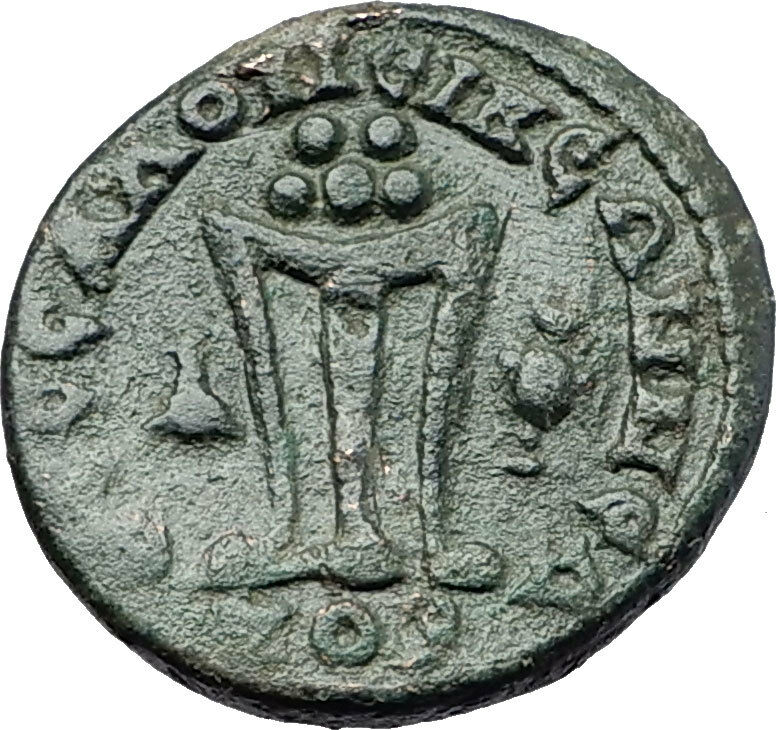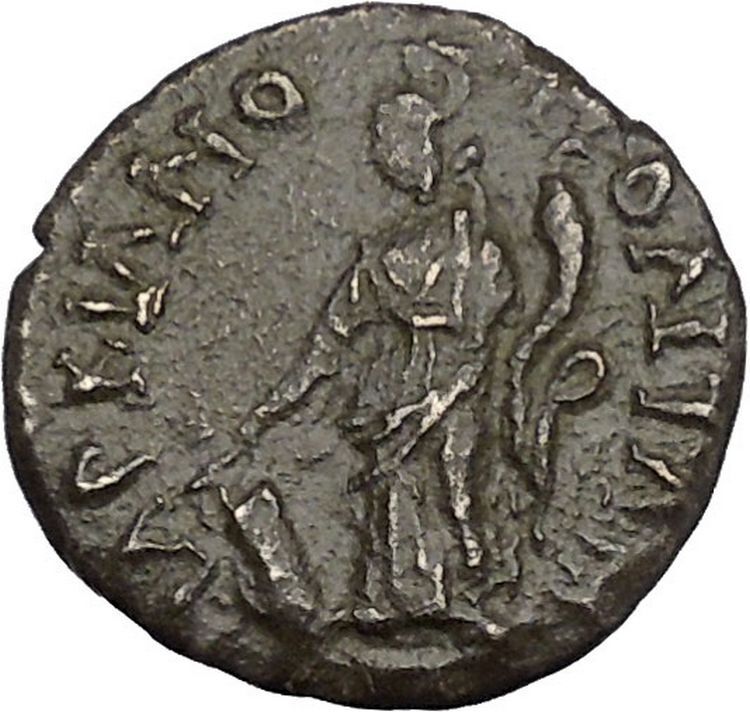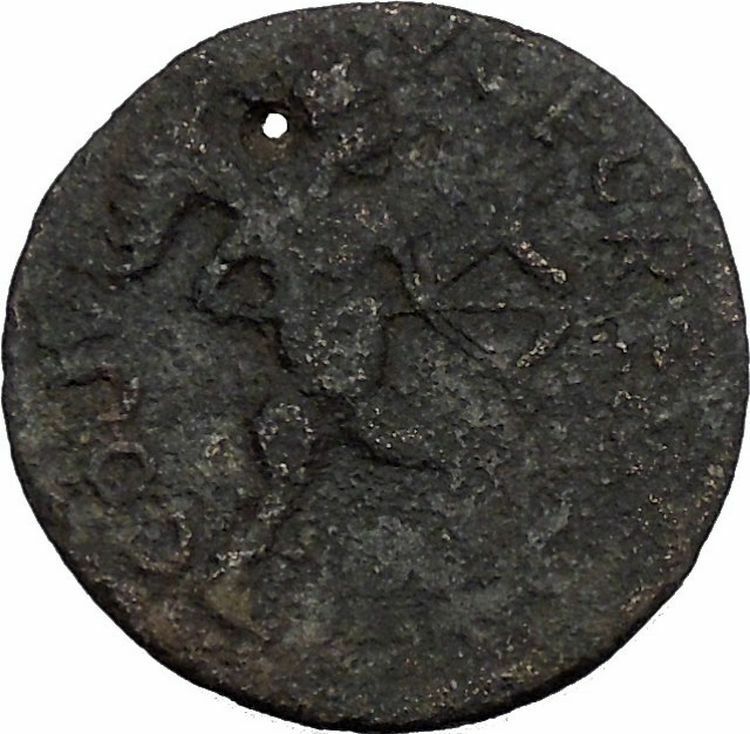|
Hadrian – Roman Emperor: 117-138 A.D.
Bronze 20mm (6.47 grams) of Apameia in Phrygia
Reference: SNG von Aulock 3492; SNG Copenhagen 211; BMC 155.
AΔPIANOC KAI CЄB, Laureate head right, with slight drapery.
AΠAMЄΩN MAPCVAC KIBΩTOI, River-god Marsyas reclining left within cavern, holding cornucopia and double flute; five chests above.
The figure on the reverse is not the satyr Marsyas, who does have his mythological orgins in Phrygia, but rather the personification of the river Marsyas, which flows from a spring in the heights above Apamea and eventually joins the Maeander. Apamea was known as Kelaenai before being re-founded by Antiochos I, and had the additional epithet of Kibotos, or “chest,” for its importance as a regional trading center.
You are bidding on the exact item pictured, provided with a Certificate of Authenticity and Lifetime Guarantee of Authenticity.
 Hadrian – Roman Emperor: 117-138 A.D. Hadrian – Roman Emperor: 117-138 A.D.
| First-cousin-once-removed and adopted son of Trajan | Husband of Sabina | Adoptive father of Aelius and Antoninus Pius | Grand-nephew of Trajan Pater |
Publius Aelius Hadrianus (as emperor Imperator Caesar Divi Traiani filius Traianus Hadrianus Augustus, and Divus Hadrianus after his apotheosis, known as Hadrian in English; 24 January 76 – 10 July 138) was emperor of Rome from AD 117 to 138, as well as a Stoic and Epicurean philosopher. A member of the gens Aelia, Hadrian was the third of the so-called Five Good Emperors.
Hadrian was born Publius Aelius Hadrianus in Italica or, less probably, in Rome, from a well-established family which had originated in Picenum in Italy and had subsequently settled in Italica, Hispania Baetica (the republican Hispania Ulterior), near the present day location of Seville, Spain. His predecessor Trajan was a maternal cousin of Hadrian’s father. Trajan never officially designated a successor, but, according to his wife, Pompeia Plotina, Trajan named Hadrian emperor immediately before his death. Trajan’s wife was well-disposed toward Hadrian: Hadrian may well have owed his succession to her.
Hadrian’s presumed indebtedness to Plotina was widely regarded as the reason for Hadrian’s succession. However, there is evidence that he accomplished his succession on his own governing and leadership merits while Trajan was still alive. For example, between the years AD 100-108 Trajan gave several public examples of his personal favour towards Hadrian, such as betrothing him to his grandniece, Vibia Sabina, designating him quaestor Imperatoris, comes Augusti, giving him Nerva’s diamond “as hope of succession”, proposing him for consul suffectus, and other gifts and distinctions. The young Hadrian was Trajan’s only direct male family/marriage/bloodline. The support of Plotina and of L. Licinius Sura (died in AD 108) were nonetheless extremely important for Hadrian, already in this early epoch.
Hadrian quickly secured the support of the legions – one potential opponent, Lusius Quietus, was instantly dismissed. The Senate’s endorsement followed when possibly falsified papers of adoption from Trajan were presented (although he had been the ward of Trajan). The rumor of a falsified document of adoption carried little weight – Hadrian’s legitimacy arose from the endorsement of the Senate and the Syrian armies.
Hadrian did not at first go to Rome – he was busy sorting out the East and suppressing the Jewish revolt that had broken out under Trajan, then moving on to sort out the Danube frontier. Instead, Attianus, Hadrian’s former guardian, was put in charge in Rome. There he “discovered” a plot involving four leading Senators including Lusius Quietus and demanded of the Senate their deaths. There was no question of a trial – they were hunted down and killed out of hand. Because Hadrian was not in Rome at the time, he was able to claim that Attianus had acted on his own initiative. According to Elizabeth Speller the real reason for their deaths was that they were Trajan’s men.
Hadrian and the military
Despite his own great stature as a military administrator, Hadrian’s reign was marked by a general lack of major military conflicts, apart from the Second Roman-Jewish War. He surrendered Trajan’s conquests in Mesopotamia, considering them to be indefensible. There was almost a war with Parthia around 121, but the threat was averted when Hadrian succeeded in negotiating a peace.
The peace policy was strengthened by the erection of permanent fortifications along the empire’s borders (limites, sl. limes). The most famous of these is the massive Hadrian’s Wall in Great Britain, and the Danube and Rhine borders were strengthened with a series of mostly wooden fortifications, forts, outposts and watchtowers, the latter specifically improving communications and local area security. To maintain morale and keep the troops from getting restive, Hadrian established intensive drill routines, and personally inspected the armies. Although his coins showed military images almost as often as peaceful ones, Hadrian’s policy was peace through strength, even threat.
In 130, Hadrian visited the ruins of Jerusalem, in Judaea, left after the First Roman-Jewish War of 66-73. He rebuilt the city, renaming it Aelia Capitolina after himself and Jupiter Capitolinus, the chief Roman deity. A new temple dedicated to the worship of Jupiter was built on the ruins of the old Jewish Second Temple, which had been destroyed in 70. In addition, Hadrian abolished circumcision, which was considered by Romans and Greeks as a form of bodily mutilation and hence “barbaric”. These anti-Jewish policies of Hadrian triggered in Judaea a massive Jewish uprising, led by Simon bar Kokhba and Akiba ben Joseph. Following the outbreak of the revolt, Hadrian called his general Sextus Julius Severus from Britain, and troops were brought from as far as the Danube. Roman losses were very heavy, and it is believed that an entire legion, the XXII Deiotariana was destroyed.[45] Indeed, Roman losses were so heavy that Hadrian’s report to the Roman Senate omitted the customary salutation “I and the legions are well”. However, Hadrian’s army eventually put down the rebellion in 135, after three years of fighting. According to Cassius Dio, during the war 580,000 Jews were killed, 50 fortified towns and 985 villages razed. The final battle took place in Beitar, a fortified city 10 km. southwest of Jerusalem. The city only fell after a lengthy siege, and Hadrian only allowed the Jews to bury their dead after a period of six days. According to the Babylonian Talmud, after the war Hadrian continued the persecution of Jews. He attempted to root out Judaism, which he saw as the cause of continuous rebellions, prohibited the Torah law, the Hebrew calendar and executed Judaic scholars (see Ten Martyrs). The sacred scroll was ceremonially burned on the Temple Mount. In an attempt to erase the memory of Judaea, he renamed the province Syria Palaestina (after the Philistines), and Jews were forbidden from entering its rededicated capital. When Jewish sources mention Hadrian it is always with the epitaph “may his bones be crushed” (שחיק עצמות or שחיק טמיא, the Aramaic equivalent), an expression never used even with respect to Vespasian or Titus who destroyed the Second Temple.
|





 Hadrian – Roman Emperor: 117-138 A.D.
Hadrian – Roman Emperor: 117-138 A.D.




